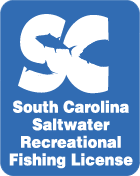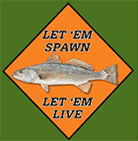Cooperative Research in Red Drum Stock Enhancement
Red drum, Sciaenops ocellatus, is an important recreational game fish that inhabits coastal waters from North Carolina to Texas. During the 1980’s, red drum populations in the southeastern US experienced sharp declines in abundance due to commercial and recreational overfishing, resulting in more restrictive creel and slot limits and the closure of commercial fisheries. Red drum, also known as redfish, are the largest members of the drum family and may live as long as 50 years, but their long lifespan makes them slow to recover from overfishing. In 1988, the South Carolina Department of Natural Resources began a research program to investigate stock enhancement as a tool to address the declining population and increase the abundance of red drum in South Carolina waters. Since the inception of the program, managers have sought ways to allow community stakeholders to participate in the program, and in 2003, the SCDNR began cooperative research on red drum with the US Fish and Wildlife Service at the Bears Bluff National Fish Hatchery on Wadmalaw Island, South Carolina.

Bears Bluff and the Marine Resources Division of the DNR have a long history of working together. Between 1946 and 1972, Bear’s Bluff served as the state’s marine fisheries research and experimental laboratory under the direction of Dr. Robert Lunz (fig.1). During this time, Dr. Lunz pioneered the culture of red drum in outdoor ponds in South Carolina. In the early 1970’s, marine research for the state moved to a newly constructed facility at Ft. Johnson on James Island and in 1983, the DNR’s Waddell Mariculture Center was constructed in Bluffton, South Carolina for the culture and production of marine organisms. After the move by DNR in 1972, Bear’s Bluff was leased by the US Dept of the Interior, first as a lab for the EPA and then as a national fish hatchery for the US Fish and Wildlife Service. In 1985, the DNR and USFWS at Bears Bluff began their cooperative research program on the ecology and potential for stock enhancement of short nose sturgeon. Today, cooperative research continues between the state and federal agencies with the red drum stocking program.
Bears Bluff is located at the confluence of the North Edisto and Wadmalaw Rivers just 7 miles from the Atlantic Ocean and is ideally situated for stock enhancement research in this estuary. Selected families of adult red drum are spawned at the Marine Resources Research Institute at Ft. Johnson and transported to ponds at Bears Bluff during the natural fall spawning season. Since 2003, ponds at Bears Bluff have produced an average of over 400,000 1-2 inch red drum fingerlings per year. Fingerlings were harvested from ponds at Bears Bluff as well as the Waddell Mariculture Center and stocked in flooded marsh grasses along the North Edisto River. Research in the estuary has focused on size of small juveniles at stocking, stocking location within the estuary, stocking timing, and stocking by boat or hauling trailer (fig. 2).

With no fisheries-independent sampling conducted in the North Edisto River, researchers are dependent upon cooperative anglers in the community to collect samples of red drum. Local fishing guides, Boy Scout troops, and high school fishing clubs have all been eager to lend a hand collecting samples by hook and line. Anglers are given collection kits and asked to take a small tissue sample or “fin clip” from any red drum captured and to record data on the size and location of the capture on data sheets. Cooperating anglers are offered a reward of a hat or t-shirt when they turn in their samples. The program provides researchers an opportunity for outreach and education about the local ecosystem while simultaneously instilling a sense of pride and environmental responsibility in the community stakeholders.
All samples collected by anglers are sent to the genetics lab at the Marine Resources Research Institute for analysis. The percentage of hatchery fish to the total number of fish collected from a year class is termed the “hatchery contribution” and measures the impact of stocked fish in the estuary. The hatchery contribution of a year class can fluctuate depending upon the strength of the natural wild year class and research treatments such as size of fish released, release timing, and release method. Contribution in the North Edisto has ranged from a low of 3% in the first year of stocking, to a high of almost 40% in 2005 (table 1.).
Table 1. Red drum stocking and contribution in the North Edisto estuary by SCDNR and BBNFH, 2003-2009.
| Year Class | WMC (n) | BBNFH (n) | Total Released (n) | Hatchery Contribution (%) |
|---|---|---|---|---|
| 2003 | - | 588,180 | 588,180 | 3.0 |
| 2004 | 145,902 | 535,373 | 681,275 | 13.0 |
| 2005 | 474,614 | 141,143 | 615,757 | 39.4 |
| 2006 | 671,174 | 446,627 | 1,117,801 | 18.4 |
| 2007 | 464,147 | 420,232 | 884,379 | 21.0 |
| 2008 | - | 620,051 | 620,051 | 6.3 |
| 2009 | - | 461,159 | 461,159 | 7.5 |
Cooperative research on red drum stock enhancement between SCDNR’s Marine Resources Division and USFWS Bears Bluff National Fish Hatchery has increased the efficiency of red drum production in South Carolina and expanded the area of coastline available for stock enhancement research. The partnership has provided opportunities for community outreach and education as well as stakeholder participation. But perhaps the most significant contribution of the state and federal agency cooperation is the increased abundance of red drum in South Carolina waters.



